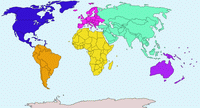Login form
Continents

You are probably on a continent right now. A continent is an enormous area of dry land on Earth. A continent is mostly surrounded by ocean. You can only see the ocean if you are on the edge of a continent. If you are not on a continent, then you might be on an island. An island is a smaller piece of land with water all around.
|
Facts About the Continents |
|||
|
Continent |
Population (2004 estimates) |
Area (square miles) |
Area (square kilometers) |
|
Africa |
875,000,000 |
1,700,000 |
30,200,000 |
|
Antarctica |
N/A1 |
5,410,000 |
14,000,000 |
|
Asia |
3,860,000,000 |
17,100,000 |
44,400,000 |
|
Australia2 |
32,400,000 |
3,280,000 |
8,490,000 |
|
Europe |
729,000,000 |
4,000,000 |
10,400,000 |
|
North America |
509,000,000 |
9,360,000 |
24,200,000 |
|
South America |
369,000,000 |
6,880,000 |
17,800,000 |
|
1. Although Antarctica has several scientific research facilities, it has no permanent population. 2. Includes New Zealand and the Pacific Islands. Source: United States Census International Programs Center. |
|||
EARTH’S CONTINENTS
Some geographers say Earth has seven continents. Others say six because they count Europe and Asia as one continent called Eurasia. The biggest continent is Asia. The second largest continent is Africa. The other continents are, in order of size, North America, South America, Antarctica, Europe, and Australia.
WHAT DO CONTINENTS LOOK LIKE?
Continents have all types of land. Continents have plains and mountains. Continents have deserts and lakes.
People build cities on continents. Almost all of the people on Earth live on continents. More people live on Asia than on all the other continents combined.
The edge of a continent touches the ocean. The edge of a continent can be smooth, sandy beach. It can be made of steep, rocky cliffs. The edge of a continent slopes down into the sea.
WHERE DID EARTH’S CONTINENTS COME FROM?
Geologists think that millions of years ago Earth had only one continent. They named this huge continent Pangaea. Pangaea broke into two continents about 200 million years ago. Geologists named these two continents Gondwanaland and Laurasia.
The continents kept breaking up and moving away from each other. Africa, South America, Antarctica, and Australia came from Gondwanaland. Eurasia and North America came from Laurasia.
HOW CAN CONTINENTS MOVE?
Continents can move because Earth’s surface is made of giant plates. The plates move around. The continents ride on these plates. The plates slide over a layer of partly melted hot rock.
In some places, the plates crash together. In other places, the plates move apart. One of the places the plates move apart is under the Atlantic Ocean. Hot, melted rock oozes up through a crack in the ocean floor. The hot rock cools and gets hard. It makes new seafloor. As new seafloor is added, the Atlantic Ocean grows wider. Europe and the United States are slowly growing farther apart.
Source: Microsoft ® Encarta

